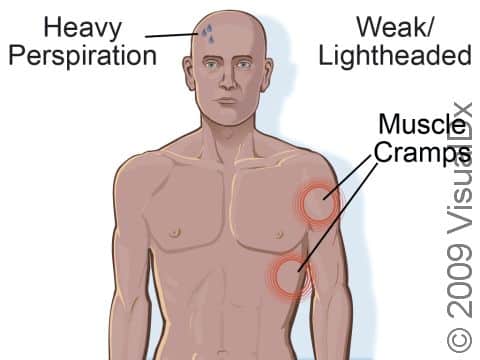Heat Cramps, First Aid
Heat cramps are a form of heat illness. Heat illness occurs when a person’s core body temperature rises above a safe level of the body’s internal temperature range. Heat cramps are the earliest sign of heat illness. Loss of salt in the body due to excessive perspiration causes painful, involuntary muscle spasms. If the person does not take precautions to cool off and rehydrate at this early stage of heat illness, more severe stages will occur in rapid progression, resulting in a potentially life-threatening situation.
See the Heat Exhaustion and Heatstroke topics if later stages of heat illness are suspected.
Who's At Risk?
People most susceptible to heat cramps are those outdoors on a hot, humid day or those inside in a poorly ventilated area, particularly children, older adults, or people who are overweight. Children and older adults may experience a fast progression of symptoms and can collapse suddenly.
Certain medications can make people more susceptible to heat illness because these medications may alter the way the body handles heat and sun.
People who drink alcohol before, during, or after vigorous activity are more susceptible to heat illness, as are people who do heavy work with inadequate fluid intake.
Signs & Symptoms
Heat cramps often present as muscle cramps (eg, in the legs, arms, abdomen, or back), heavy perspiration, and weakness or lightheadedness. The cramps are often more painful and last longer than the type of leg cramps that occur during the night.
You can differentiate the least-severe form of heat illness, heat cramps, from more severe forms by comparing the person’s symptoms described above to the following:
- Heat exhaustion includes feelings of nausea, lightheadedness, and thirst, and the person may act irrationally, have dilated pupils (pupils larger than normal), be very sweaty, or have cool and moist skin that is either red or paler than usual.
- Heatstroke includes some or all of the following symptoms:
- A high body temperature (above 102°F [38.9°C])
- Skin that is red and hot with lack of sweating (sweating has stopped)
- Small pupils
- A rapid, weak pulse
- Rapid, shallow breathing
- Extreme confusion or irritability
- Weakness
- Seizures
- Unconsciousness
Self-Care Guidelines
First Aid Guide
Use a combination of the following measures, depending on the circumstances and means available:
- Have the person rest and try to cool down in a shaded area or in a cool or air-conditioned building, room, or car.
- Give the person an electrolyte beverage (eg, Gatorade or Pedialyte), clear juice, or water. Note: You can make a salted drink by adding 1 teaspoon of salt to 1 quart of water.
- If the person is alert, pour water over them or spray them with a hose.
- Wrap the person in wet cloth and position a fan toward them. Evaporation of water on the skin aids in cooling.
- Apply cold compresses (eg, to the neck, armpits, groin).
- Attempt to relax the cramped muscles by stretching and massaging the muscles gently but firmly.
- Avoid strenuous activity for a few hours.
If possible, take the person’s temperature while starting cooling measures and continue to check their temperature every few minutes. Once it has gone down to 100°F (37.8°C), you can discontinue cooling measures, but continue to check the person’s temperature every 30 minutes for a few hours.
Treatments
A medical professional can treat any associated dehydration and address any other illness or condition that may have caused the heat cramps.
Visit Urgency
If you suspect heatstroke, if the person does not improve with the above self-care measures after an hour, or if the symptoms worsen, seek emergency medical care.
Trusted Links
Last modified on August 9th, 2024 at 11:27 am

Not sure what to look for?
Try our new Rash and Skin Condition Finder
